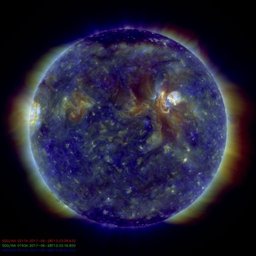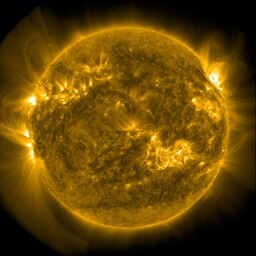About SDO
Informational Links:
SDO: The Solar Dynamics Observatory is the first mission to be launched for NASA's Living With a Star (LWS) Program, a program designed to understand the causes of solar variability and its impacts on Earth. SDO is designed to help us understand the Sun's influence on Earth and Near-Earth space by studying the solar atmosphere on small scales of space and time and in many wavelengths simultaneously.
SDO's goal is to understand, driving towards a predictive capability, the solar variations that influence life on Earth and humanity's technological systems by determining
- how the Sun's magnetic field is generated and structured
- how this stored magnetic energy is converted and released into the heliosphere and geospace in the form of solar wind, energetic particles, and variations in the solar irradiance.
Images
Below are some of SDO's Latest Images.
 |
 |
 |
 |
Launch
- SDO launched on February 11, 2010, 10:23 am EST on an Atlas V from SLC 41 from Cape Canaveral.
Science
SDO will study how solar activity is created and how Space Weather comes from that activity. Measurements of the interior of the Sun, the Sun's magnetic field, the hot plasma of the solar corona, and the irradiance that creates the ionospheres of the planets are our primary data products.
Instruments
SDO has three scientific experiments:
- Atmospheric Imaging Assembly (AIA)
- EUV Variability Experiment (EVE)
- Helioseismic and Magnetic Imager (HMI)
Each of these experiments perform several measurements that characterize how and why the Sun varies. These three instruments will observe the Sun simultaneously, performing the entire range of measurements necessary to understand the variations on the Sun.
Specs
SDO is a sun-pointing semi-autonomous spacecraft that will allow nearly continuous observations of the Sun with a continuous science data downlink rate of 130 Megabits per second (Mbps). The spacecraft is 4.5 meters high and over 2 meters on each side, weighing a total of 3100 kg (fuel included). SDO's inclined geosynchronous orbit was chosen to allow continuous observations of the Sun and enable its exceptionally high data rate through the use of a single dedicated ground station.